Do you remember the time when you were telling yourself you will never spend $1000 on a phone? Yet you might read those words on a phone that costed you this price, and now you feel happy about it. That is Brand marketing power.
And brand marketing, which is also named branding, doesn’t just apply to your phone.
We all have our own prefered brands: for our phone, our clothes, our food… And now you are probably thinking about one of the brands you like while you are reading these words.
You feel sensations in contact with these brands: satisfaction, pleasure, attachment … You commit yourself to these brands. You trust them, you recommend them, you defend them… you might even work for one of them!
As a consumer, we have all already been influenced by brand marketing to certain degrees. And in a way, we are taking part in the branding process of our favourite brands by showing our commitment to them.
Actually, you have even practised branding without being aware of it – which is also called brand marketing.
By definition, you are doing branding as soon as you own a brand, or sometimes when you work for a brand. But not only…
When you are applying for a job, you are using personal branding in a certain way. You are showing who you are, your personal values, show your values and your skills…
We are talking about the employment market, that is not a coincidence. You are trying to differentiate yourself among your competitors to have the best reputation, to make the best impression in people’s mind in order to get the job. That is the same for companies, with brands
We are all concerned by branding, directly or indirectly, consciously and unconsciously. And the more time passes, the more important the branding becomes. That’s why certain company positions as Chief Brand Officer – CBO – are emerging.
In a world where, thanks to the digital revolution, it becomes easier and easier to create a company and launch a brand, branding can allow you to become the first choice in people’s minds.
As a result, they will turn to you the day they have a particular need or desire that they know you can satisfy well. And ultimately, becoming so obvious in their mind that they would not even consider the other brands or your prices. They will trust you.
That is mainly due to incredible branding that brands such as Coca Cola, Apple or Louis Vuitton are nowadays so successful, profitable and may account you among their loyal customers.
But why Brand Marketing is so powerful? What is exactly Branding? Where it comes from?
What are the differences between a Brand, Branding and Marketing?
How can I use it for my brand or personal brand?
1. Origins of branding
A) Brands
1. The first brands:
The word “brand” comes from the Germanic root of brend/t, which gives “brennen” in German meaning “burn” in English.
For the Antiquity, merchants used specific hallmarks or markings to distinguish their products. These symbols also allowed them to make themselves known to customers and build customer loyalty.
The brand was then considered as a kind of identity for the manufacturer and a sign of the quality of its products.
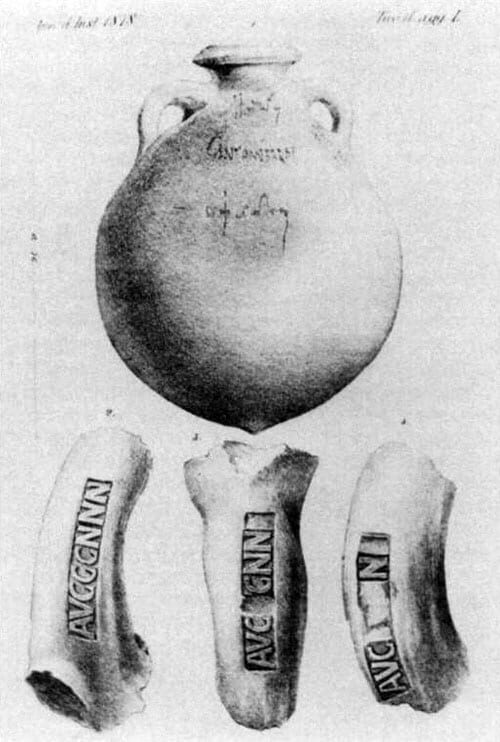
At that time, some artisans grouped in corporations to be more profitable. And there were already regulations in some countries. They had to indicate on their products the sign of their organisation.
By the way, counterfeiting was already punishable at the time.
Thus, people could find marks or signs on different products such as very old pottery, or even on the bread loaf of bakers. Brands were already existing thousands of years ago.
But the word “branding” emerged after.
2. Branding:
The word “branding” comes from the English word “brand”, which is related to the word “burn”. So the word branding has something to do with burning.
Indeed, in medieval times, branding was the fact to mark a sheep or a bovine by the fire with a logo in order to identify the owner. It was still the case during the conquest of the West in the United States.
The branding of herds was already designated by the term “branding”.

It was also in medieval times that other distinct visual languages appeared. One of them was the blazons.
The blazon was used to visually attribute a certain social status to the wearer. Thus, a specific combination of colors and shapes represented a given noble family.
And all these shapes and colors were combined to create a unique blazon, representing the family in question:

Does that remind you of something?
3. The industrial area
During the beginning of the industrial area – from the 19th century – producer’s brands became popular.
The manufacturer of a product had to be demanding about its creation. It was a matter of manufacturing quality products despite bigger amounts.
But it was also a matter of making consumers aware, via brand naming, of the origin of the product and the conditions of manufacture to win their loyalty.
It was not a coincidence that modern advertising emerged in 1836 during this industrial area.
It has started in the newspapers:

Emile de Girard was the first to have the idea to insert advertisements in his La Presse journal in order to boost his journal profit. And it was a way for the company to increase its awareness and to promote products.
And then appeared in the 1870s, the first registered logo to be trademarked:
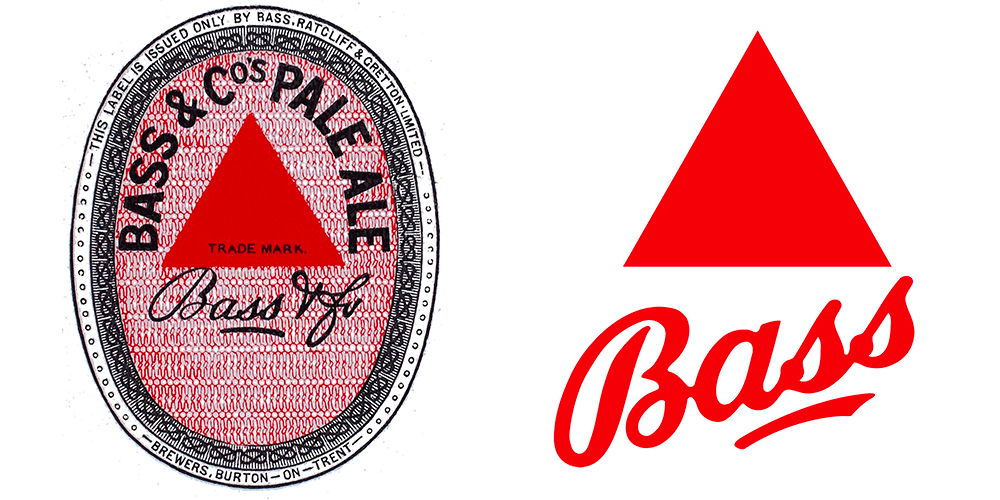
The Bass red triangle was precisely born in 1876 and use a trademark in 1876. This logo marks the beginning of the current era of logo design.
Using the power of modern advertising combined with recognizable brands, many producers’ brands were developing themselves during the industrial area.

However, the distribution networks were not as developed as today.
Businesses proposed products to respond to the general demand without questioning themselves about consumers, their needs and their desires.
The production quantities were often wrong and consequently, they generated financial losses for companies.
It was before Marketing came, which will bring brand marketing – more commonly named branding
B) Marketing
Whereas selling is more about persuading people, which lead to action, Marketing is more subtle. Marketing is more about influencing people.
Marketing as we know it nowadays is in fact practised unconsciously since commerce is born. Merchants have always tried to influence the behaviour of their customers.
But reflections about marketing and its conceptualizations came way later.
1. Marketing history
Marketing historians still disagree on how to date the beginnings of marketing thought. Most of them, like Bartels, in his book The History of Marketing Thought, suggest that the marketing theory emerged when the universities started offering marketing courses, at the beginning of the 20th century.
It was precisely in 1902 that the University of Michigan, located in the USA, delivered what many believe to be the first course in marketing.

Before marketing, companies saw the market as a whole unique market, that is to say, a set of consumers.
With the invention of marketing, the notion of market segmentation emerged. Companies started questioning consumers about the different product characteristics they liked or were looking for.
“What colour would you like your car to be?” or “Would you like your car to be bigger or smaller?” Some wanted faster car whereas others wanted a more comfortable car.
2. Market Segmentation concept
The concept of market segmentation – a market designates people, not the products – is based on both quantitative and qualitative researches.
That is simply a matter of seeing a market made of several parts, which added up formed a complete market, instead of a whole.

In other words, “people who want a faster car” can be the blue segment and “people who want a comfortable car” can be the yellow segment on the graph. They are two different segmentations on this circle. And this circle represents the car market.
However, market segmentation is not science, and there are no common rules. It is up to companies to define their own market segments. Sometimes mistakes, such as over-segmentation, happen and can consequently cost money to businesses.
Market segmentation is a fundamental contribution since it allowed companies to adapt and calibrate their offer to both avoid production waste and reach more efficiently people.
Besides, the interest of a well-made segment for a company is to be able to bring products or services to any type of consumers through different brands, and therefore to cover the whole of its market.
3. Adapted offer trough brands
For example, the Volkswagen brand, from small cars to medium cars, proposes a multitude of models to suit all tastes.
But in the end, the Volkswagen brand doesn’t go through all the levels, since the Volkswagen brand doesn’t sell very high-end cars.
Actually, this is rarely possible for one brand to cover all market segmentations. It would even be a non-sense for Volkswagen to sell high price cars, since, translated from German, Volkswagen means “the car of the people.”
And a $200,000 car is obviously not for everyone.
In order to be able to position itself on very high-end vehicles, the Volkswagen became more than a brand.
They have created a group and started acquiring other brands, such as Porsche or Lamborghini, to cover new market segmentations:

That is why Volkswagen Group owns brands such as Seat and Skoda for the lower end of the range, Volkwagen and Audi for the middle and upper end, and Lamborghini and Bugatti for the very, very high end.
When the segmentation of a company/group is well done, this company will be able to cover the majority of a market, or all the market, thanks to its different brands.
And by extension, some groups can cover unrelated market via different brands, such as Louis Vuitton Moet Hennessy, Coca Cola Co. or Unilver does:
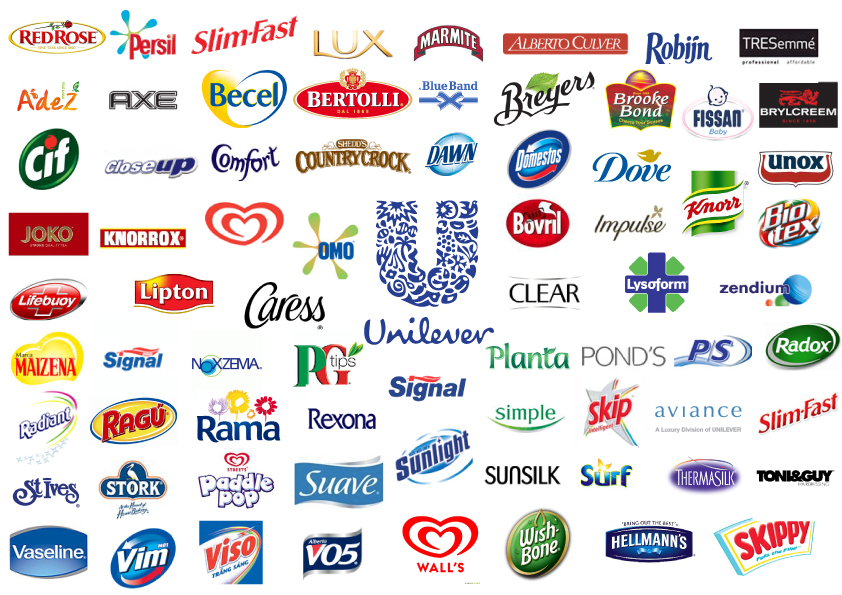
Would you be tempted to feed your children with biscuits commercialized by the same brand that sells detergent and deodorant as well?
That makes sense.
4. Marketing defition
Now that we see the main notion related to Marketing, we can define it.
Marketing is the analysis of consumer needs and the set of actions used by organizations to influence the consumer’s behaviours.
Therefore, Marketing is really broad.
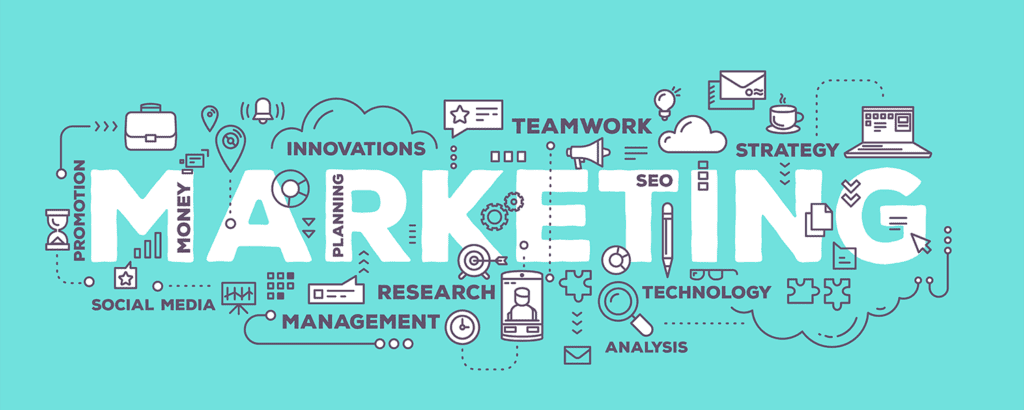
It goes from asking people about their car preferences to create a car TV commercial.
Therefore, Marketing includes the logo, the brand name and the tagline… since all those elements influence the customer behaviour.
But was marketing not enough to talk about brands? Why are we now talking about brand marketing, and what the difference?
2) What is Branding – or Brand Marketing ?
Branding is a nebulous notion, which is, unfortunately, often mishandled. The term is often confused with other terms in people’s minds, such as marketing, brand or brand strategy.
You might have read more in other popular articles on Branding some phrases such as:
– “Branding and marketing are distinctly different”:
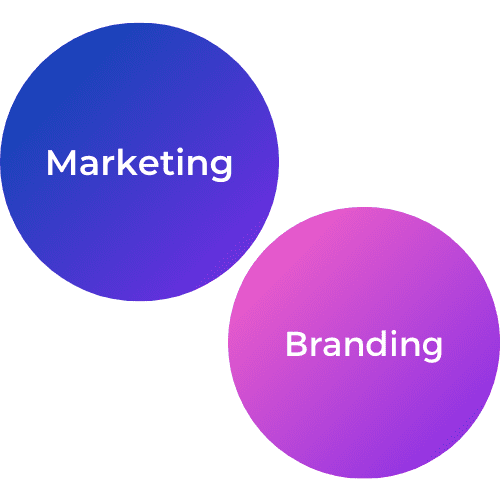
But why branding is also called brand marketing? What is consequently a logo design, branding or marketing
– “Branding comes first, marketing comes second”,
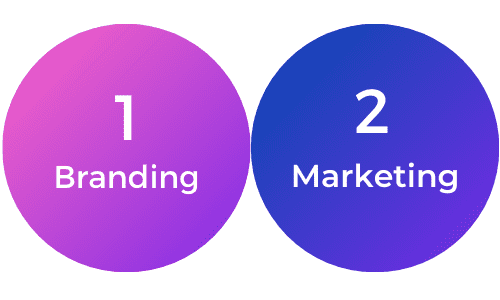
But why any good brand strategy includes and starts with “the analysis of consumer needs,” which is purely marketing? How can you create a relevant brand message if you don’t know the people you are talking to?
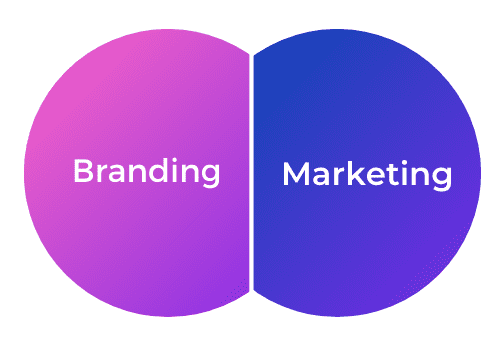
– “Marketing drives sales, branding drives recognition and loyalty”,
But Loyalty is actually the best way to drive sales, so branding drives sales, is it not?
Why as soon as e-commerce owners improve their website branding, they increase quickly their conversion rate, and therefore, their sales?
For now, the best thing is to start fresh:
Branding is also named brand marketing. Therefore, we can start by acknowledging that brand marketing – branding – is a subcategory of marketing.
And as a result, we also acknowledge the fact that both are closely linked.
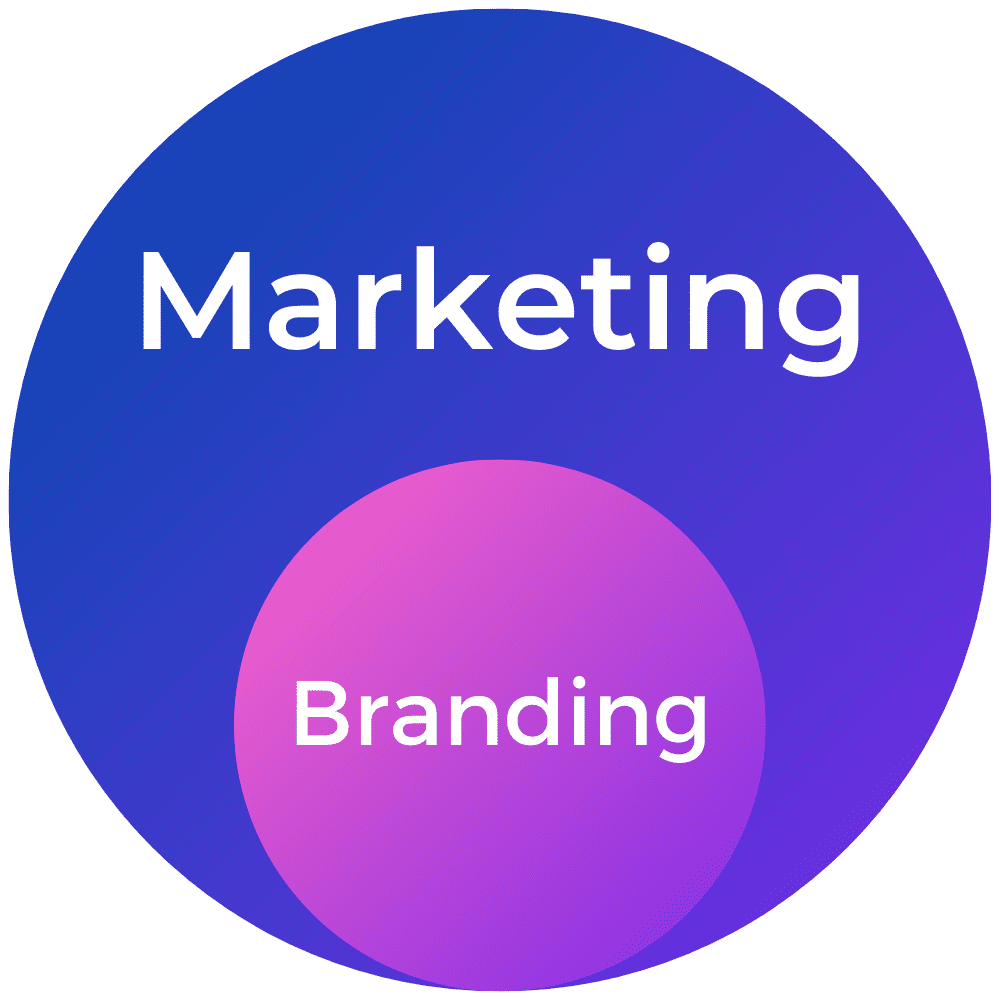
Now, what is the difference between those two disciplines?
A) The difference between Marketing and Branding
The difference between Marketing and Branding is much more subtle than people think.
1. Consumer’s feelings
As a consumer, we have a “relationship” with brands. Sometimes they satisfy us, sometimes they disappoint us: we are feeling emotions through brands.

When the consumer is attached to the brand and has a good image of it, overall he expects the price to be a little higher than the standard market price.
A small price for a “big brand” creates a lack of understanding among the consumers.
And when he doesn’t find that the price is a little or very much higher, he is almost “disappointed“. He ends up wondering if the image he had of his product or brand is not an oversized image.
Let us imagine that Apple starts selling their iPhones 500 dollar tomorrow instead of 1000, what would you think?
“Was it not supposed to be quality? I thought they have the best smartphones in the market.” ; “why did I pay 1000 dollars before and now 500 dollars?”; “Did they fool me? Am I just paying for Marketing?” …
Do you remember how outrageous were Apple fan’s when the brand released the iPhone 5C, which was the first “cheep” Iphone?
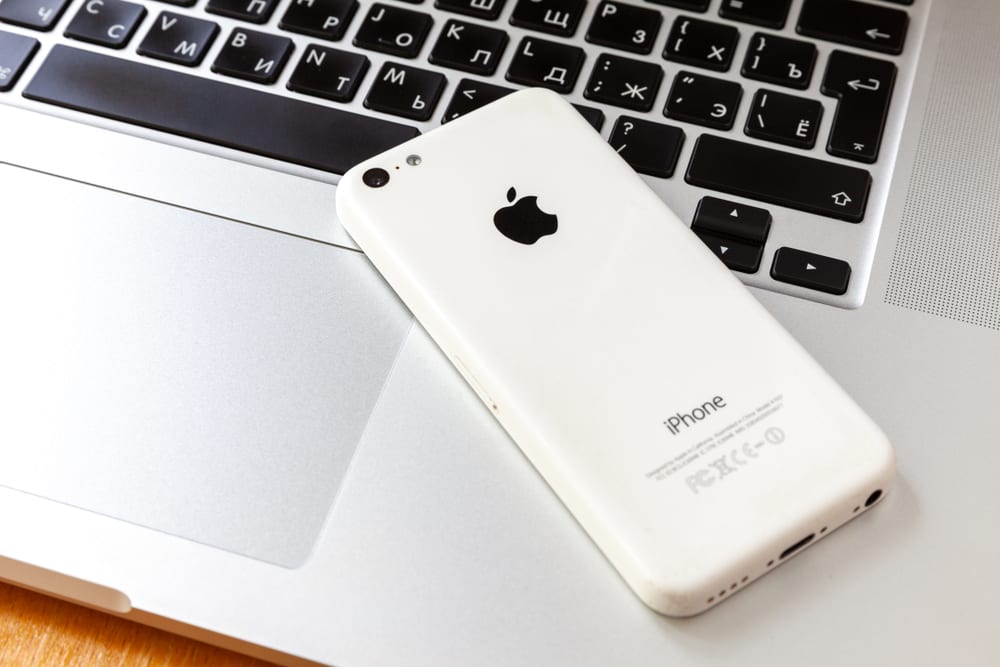
We may assume some Apple’s fan feelt so angry or so disappointed by how cheap it looks, by the low prices not as high as the usual ones.
Even as a “simple holder” of an old iPhone, you may feel unconsciously reassured when you see that the prices are still higher than the competition.
High prices are often synonym quality in people’s minds. You paid for the best, so it should still be the best in some way.
Some Apple fan might even have moved away from the brand because they were thinking the quality was decreasing.
Please do not forget that we are talking about people ready to camp for having their new iPhone first:

This may seem very paradoxical, even totally absurd because as consumers, we often rather pay less.
Yet this phenomenon is real and more general than we think. To understand it better, here is a concrete example:
2. Lamufa stollers case study
Georges Lewi, a French branding expert, conducted an audit of the baby comfort stroller brands for Lafuma.

They found that there was a price elasticity of 7 to 8% for their strollers. This means that Lafuma could increase the price of its products by 7 to 8% without any negative financial impact for the company.
The difference seems small, yet it is quite significant since the marketing price of the strollers was 280 euros, or $330.
Naturally, the president of the company followed the recommendations, since this allowed him to increase his margins potentially while having similar costs.
If we are a bit logical, we can assume that the amount of sales would decrease, since the price increase of €40 or $50.
Afterwards, they noticed that consumers kept buying the products despite them being 7-8% more expensive. More surprising, the number of products sold increased!
Mystery! It seems almost irrational, and yet:
Georges Lewi’s team did not stop there. In order to be able to unravel this mystery, they began to re-interview consumers. And they found an explanation.
The primary motivation for parents buying a stroller is “the safety of his baby.”
When the baby comfort stroller was worth €280 ($330) while competitors’ strollers were “only” worth €270 ($320), consumers considered that the products “should be pretty much the same”.
When the price of the product increased significantly, but not excessively, from €280 to €320 ($380), consumers perceived the product as more qualitative, more reliable, and above all, coherent with their image of the Lafuma brand.
He, therefore, turned to this stroller while being almost reassured to see that the brand of the stroller in which he was raised remained a very good brand.
What could we conclude?
In this case, the fact to sell higher price products were more in adequation with the image consumers have of the Lafuma brand.
This better coherence between brand identity and the pricing created a more reassuring feeling for consumer, which is very important because the product directly concerns the health and safety of their child.
This explains why people perceived more value in a 320€ stroller than in exactly the same stroller at 280€, which was almost the same price than the competition.
3. The difference
The difference between Marketing and Branding is, therefore, a difference in thinking value creation and the pricing of a product/service in relation to the market.
Marketing is thinking of the price from a “company perspective”. The value of a product is depending on different variables, such as products costs & development, taxes, margin and the market.
Products are market markers, and the pricing approach is more rational and logical. Therefore, to create value, you need to improve the product/service by adding features, for example.
To illustrate it better with the Strollers, Marketing mindset would have leaded us to this reflection:
“If we put our stroller price higher, and consequently higher than the competition, without improving the product, we would sell less strollers. But we are going to our marge since the product costs will be the same.”
Branding is thinking the price from a consumer perspective, with her/his needs, her/his emotions and her/his aspirations.
Indeed, the product is a mental marker in a market, which irrationally depends on the value perceived by consumers. Branding has a global approach focused on the perceived value through different elements.
This perceived value is therefore subjective and personal. It means the perceived value of your brand can be high for someone, and very low for someone else.
It can be influenced by several factors:
– the consumer’s knowledge of the products & the market
– the global experience people have with the brand
– the branding visual identity
– the price
…
In our stroller case, a Branding is mindset is more like:
“Lafuma is known for being a quality and reliable brand. The stroller price should reflect it to ensure more coherence in people’s mind since the price is perceived as a quality indicator.
That would ease people to understand the value or our Lafuma strollers. Therefore, they will be more inclined to buy them even if they have to pay more then before”.
To sum up, the main difference between marketing and branding is the value creation approach, with branding being more focused on the perceived value.
We have previously deduced that Brand Marketing – or Branding – is a subcategory of marketing.
Therefore, all your branding actions are marketing actions in some ways. As simple as that.
It means working on your Logo Design, Brand visual identity, brand history… and even your brand strategy, are both branding and marketing actions.
They are all intended to influence consumers behavior.
And that is also explaining why good branding strategies start with a consumer analysis, which is purely marketing.
B) Branding definition
Now we have understood the slight difference between marketing and branding, we can more easily define what is a brand and what is branding.
1. Brand definition
On a legal perspective, a brand is an entity that is owned by a company. They are financially valued and they can be traded between companies.
In people mind’s, a brand is a lot of different things. It may be very unclear.
For some people, Brand is a logo. The logo is a very useful tool but it is not a brand.
Logo is a symbol of the brand.
Other people are considering Brand as something you buy. They say “I am buying this brand.”
In fact, they are talking about buying the products or the services of the brand. But a brand is not products or services.
A brand is not a promise as well. It can end up acting like one but that is not what is a brand.
Here are is a very interesting definitions of what a brand is:
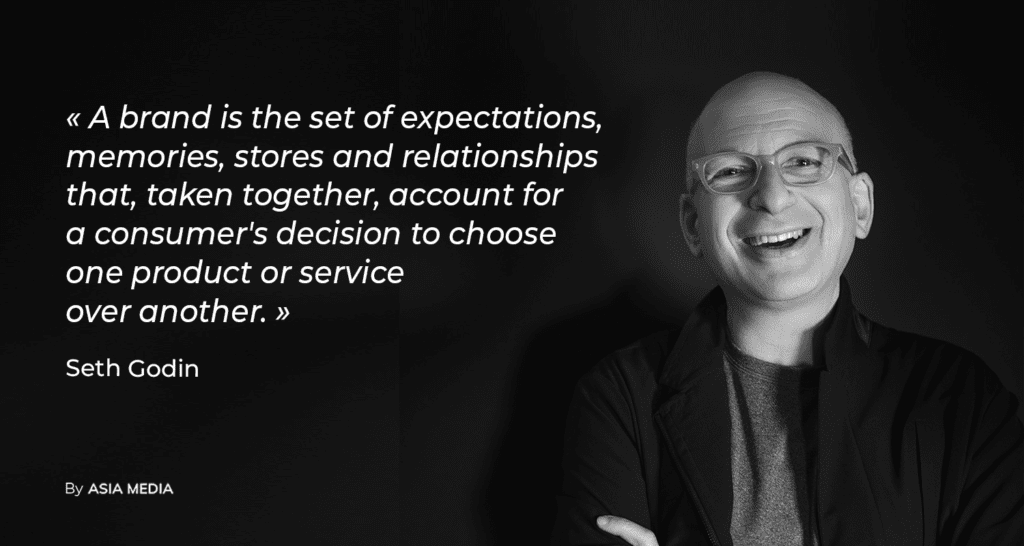
In other words, Brands give us a global impression as consumer that plays a central role in our decision to purchase a products/services from a specific company over another.
By extension, it is the case for workers as well. Indeed, this global impression can even give us the desire to work for a brand or a company.
According to Marty Neumeier, who is a branding expert:
“A brand is a customer’s gut feeling about a product, service or company. It ends up in their heads, in their hearts. Brand is a result.
They take whatever raw materials you throw at them and they make something out of it. They are creating it. ”
It means this result, this impression, is personal, since it changes from one person to another, and subjective, since each person has his own perception:
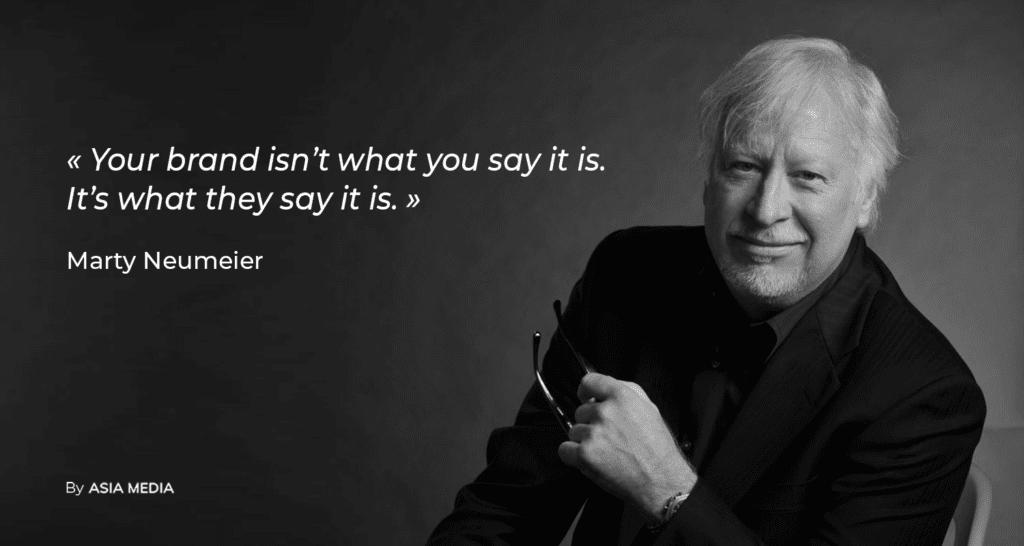
This quote from Marty Neumeier is really interesting because it implies that a brand is a reputation. Reputation is what people say about someone or something.
And that is exactly what the wealthiest man in the world – mainly due to his brand success – declared:

In order quickly sum up what a brand is:
Brand is an impression, brand is a reputation that people have.
Brand is a result in people’s mind.
Then, we can easily understand what branding is about:
2. Branding definition
If a Brand is a result that people have in their mind, then Branding is the discipline aimed to improve this result.
Branding is about improving this general impression, this reputation that people have of your brand though a set of choices & elements.
There are obvious ones, such as logo design, website design, packaging design…
And much more subtle ones, such as the values you shows, the way you are communicating with your audience, how you treat your customers…
Here is another general definition:
Branding, or brand marketing, is a part of marketing that designates all the reflections and actions carried out by a company around a commercial brand to strengthen the impression people have of it in order to make them choose this brand over others.
It implies three things:
First, since the day you created a brand, you have done branding, whatever you were aware of it or you were not.
Second, branding has to be focused on people mind. It is what they you think about your Brand which matters. Brand is a result and therefore, branding is more than an addition of elements and actions, it is a general approach.
Third, branding never ends because brands are either evolving or dying. Branding is a long term and consistent work, but positif effects can appear as soon as your work on it.
Here is a non-exhaustive list of the Branding main functions:
- showing the products/service values and improving your brand, service and products perceived value.
- making your brand recognizable and known by people, and ultimately, unforgettable.
- engaging your customers in your brand and then make them loyal.
- ensuring consistency and coherence between all your brand elements & actions, including your products, services, website…
The ultimate purpose of branding is to anchor a brand in its audience’s mind in order that they think first of this brand, without considering competitors or prices, on the day they have a particular need or desire the brand can satisfy.
We are talking about establishing a trustful relationship between the brand and its consumer’s.
By extension, branding strongly contributes to creating communities around your brand and, more incredible, they might even recommend you to other people or advocate your brand… for free!
To have a concrete example, what brand do you think of first when you think about the following word:
Smartphone
Now, what is your current smartphone brand?
Mainly, the answer to these previous questions would be the same. And if it is not the case yet, that could be it in a near feature.
Then, did you recommend it to your friends?
Actually you might have already done it without getting any money back. Which is crazy when you think about it. Free advertising, also named “Word of mouth.”
Now you might be wondering where branding starts and ends? What are the branding elements or actions?
As I told you before, branding is a whole impression that involves distinct actions and elements.
Before listing the branding elements, I would like go dig deeper into the metaphor Jeff Bezos did between the brand and the human reputation:
3) Analogy
Brand is for a company what reputation is for Human being.
As a person, you have your own values, your own principles, you own way to express yourself, your own appearance, your style… To make it simple, you have your own identity. It makes you unique.
And you can decide what Identity you want to have as a human.
But somehow, your environment have an impact on your identity as well. Your Identity is something both conscious and unconscious.
Even if you have made strong choices about who you would like to be, there will always be a difference who you want to be and who are.
Maybe you are not as fit as you want to be, as efficient as you want to be, as dedicated as you want to be…
That is the same for brand! Identity is something you can not totally master.
We can go deeper:
As a human being, everything you do or you don’t do is telling something to other people, about yourself, who you are and your personality. Even the smaller things that you are doing without being aware.
Let us imagine that you are in the street around people. As a sudden, a fight between two persons is happening. What will you do? Are you going to stop it or let it happing?
Your action – or non action – will have an impact on your perception of who you are. It it will also have an impact on the perception the people around you have of you. On what impression they have of you, what they are thinking of you.
Your action – or even non-action – will affect your reputation. It works the same for brands.
In the other way, your reputation as a human may precede you: what people perceive of you – or your identity – may suggest to them what you would do or will not do.
And if you undertake an action that is not in adequacy with the impression people have of you, it would create surprise in people’s mind.
Going beyond what people are expecting of you can create good or bad emotions in their mind. That is the same for brands.
And as a human being, your emotions are strongly linked with memories, either they are positive or negative. Indeed, Memories involving strong emotion are often better remembered than memories involving fewer emotions.
We can see Emotions are the cement of memory for human beings.
That is why you can probably remember, for example your best friend in your childhood, or for your first car.
This is why you can also remember the last person who deeply disappointed you. Or a bad experience you had with a brand.
As a human being, you will naturally surround yourself with people who give you good emotions. That works the same for brands.
Remember: Brand is a impression, a reputation. Brand is a result.
Now, you can easily understand why the actions you undertake or don’t undertake, as a brand, can have an impact on your brand.
This impact – either positive or negative – can stay on the short term, on the long term or even forever.
We can conclude this analogy by saying that all the actions concerning what people will think of your brand is branding, to a certain degree.
Logo Design is branding. Advertising is branding. The way your customer support answers to your client is branding.
And if we are taking a look at what is the CBO job position definition on wikipedia, it confirms it:

A CBO is overseeing advertising, customers services, public relations as well. Because he does branding.
Here is a quick sum-up:
- All your actions – or even non-action – can affect your reputation.
- All the actions concerning what people think of your brand is branding, to a certain degree.
- You will naturally surround yourself with brands that give you good emotions.
Great branding might therefore have a great impact on your brand. But a simple misstep might have a really bad one:
4) Examples of Branding impact through advertising
Now we have understood that branding gathers all the actions to strengthen the reputation, the impression that people have of your brand, we can take a closer look at this actions.
Advertising, and especially TV Commercials, are a good and original branding example:
Apple
If you take a look at the Apple commercial, they perfectly reflect the brand.
They are mainly focused on creativity, simplicity, and more recently, data protection & privacy:
First, the ad is perfectly reflecting Apple Brand with both a brand message, which is always very simple, and Apple visual identity through the sober aspect, the fonts and the logo. As usual.
Second, the ad above quickly makes you understand why data protection is dangerous. The ad let us imagine how we might feel if it even happens to us by highlighting the people emotions. They make you see the problem it could be.
Then Apple show you the solution: the Iphone. And they presents data protection as an iPhone feature. We see it as an advertisement for an iPhone.
“Privacy. That’s iPhone.”
Actually, I do not think this advertisement campaign as for purpose to sell you an iPhone, at least, not directly. If you notice, they don’t sell a particular Iphone model.
This commercial is mainly about making evolve the reputation we have of Apple, behind the fact it is true or it is not. It is talking to both consumers and non-consumers.
A reputation from “They are doing great products” to “They are doing great products and they are protecting my privacy, as well”
A brand is a reputation. And a TV Spot is a great way to propage it, when it is well done…
Pepsi
In 2017, Pepsi launched a tv spot with Kendall Jenner. If you remember, this advertisement made such a bad buzz at that time, especially in the United States of America.
However, we are talking about a company which makes billions of dollars in sales, which have a whole team dedicated about advertising with million dollars budget. And yet…
This TV commercial showed manifestations, that strongly looks like the ones of the black lives matter movement from 2017, featuring Kendall Jenner as a protagonist, and using a Pepsi as the miracle solution to solve conflicts.
And Kendall Jenner, which is a personal brand, is definitely not known for being engaged or even directly concerned.
However, we can suppose that it was well-intentioned. The company declared they tried to “project a message of unicity, peace and understanding.”
In other word, to strength the reputation they want have. But it did the contrary.

The advertisement was quickly taken off and Pepsi communicated public apologizes, but it was already too late…
Such a bad move it is for Pepsi with this advertisement campaign, which probably cost months and millions of dollars to create, and especially the losses of thousands of consumers.
It even made some free advertising for the competition, with people starting massively to share the hashtag #IDrinkCoke.
Even with good intentions and professionalism, branding can generate a very bad impact on your brand.
Tesla
Now, we have seen examples of what branding can do, we can take a look at Tesla advertising in comparison to Apple and Pepsi. Do you have one in mind
Actually, you can’t, because the company does not invest in Social Media Advertising or Tv commercials.
Elon Musk says that Tesla uses what other automakers spend on advertising to improve their products:
“Tesla does not advertise or pay for endorsements. Instead, we use that money to make the product great.” Elon Musk
And that statement is totally matching with the Tesla brand’s mission, which is “to accelerate the world’s transition to sustainable energy.” according to their website.
Remember, Branding is about what you do and also about what you do not do.
Now we have seen the impact branding, through one main element which is advertising, can have, we will list the different branding elements in the next part.
3) Main Branding elements
As we see previously, Branding is about improving on the experience, the impression, the reputation you give to people and your customers through the set of actions you undertake as a brand.
It is a whole of elements. But some elements have more impacts than others.
We can distinguish them in three main brand components:
A. The “brand spirit”
B. The way you communicate
C. The brand visual identity
Each components have an influence on the one it follows.
However, list all the branding elements of a brand is almost impossible, because it could include all the actions of a brand. But we can list the main ones.
A) The brand spirit
- Values
- Principles
- Mission statement
- Brand Naming & Domain name (Naming agencies)
- Tagline
- Promess
- …
B) The way you communicate
- Message:
- Medias
- Character
- Tons
- How you talk to your community
- Editorial Calendar
- Interlocutors
- …
C) Brand Visual Identity
- Logo
- Brand Guideline with brand Colors, Font, moods
- Packaging
- Brochure
- Advertisement
- Website design
- …
If you would like to create or improve your brand, we can help you.
